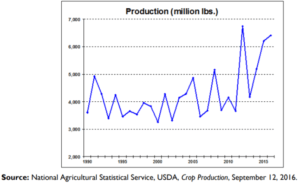Kraft Heinz’s Planters: can Mr. Peanut take the heat?

Planters’ Mr. Peanut has been around for over 100 years, but climate change may prove to be a formidable match for the iconic brand
Planters’ Mr. Peanut has been around for over 100 years, but climate change may prove to be a formidable match for the iconic brand. Planters currently sits under food giant Kraft-Heinz ($26.5B in revenue in 2016), with over $1B in sales, primarily of peanuts, cashews, and mixed nuts [1]. While certain headwinds like a change in taste preference toward almonds and pistachios may be capturing management’s attention in the short term, climate change is a force that may have a significant impact on Planters supply chain in the medium to long term.
A draft of the 2013 National Climate Change Assessment asserted that if climate change continues at its current pace, crops like peanuts could become scarce by 2030 [2]. This is because peanuts require a very specific environment to grow well, with up to five months of consistent warmth and just the right amount of precipitation. Too little precipitation can result in mold and aflatoxin contamination, and too much both reduces yields and makes harvesting more difficult [3]. As climate change increasingly results in more volatile weather conditions, this can affect peanut yield and thus prices. For example, in 2011, an abnormally hot and dry summer in the American South (where peanut production is concentrated) led to a 13% reduction in US peanut output and caused the price of Planters peanut butter to increase by 40% [4]. While the usage of precision agriculture and other technology usage may mitigate the effects of climate change to some extent, farmers and Planters will need to stay ahead of the curve as climate change increases year to year variability and harms yields.
Current approach
Kraft Heinz at the corporate level strives to do its part in fighting climate change with sustainability goals that aim to reduce greenhouse gas emissions, energy and water consumption, and solid waste at its manufacturing facilities all by 15% by 2020 [5]. This is also true at Planters: one Arkansas plant was even recognized by the state government for its sustainability efforts [6]. Previous Planters efforts under the “Naturally Remarkable” campaign also built green space in communities, sought to reduce packaging and shipping waste, and supported the Sustainable Agriculture Initiative Platform [7]. Still, the company’s efforts to reduce its own carbon footprint are unlikely to move the needle on global climate change, and the more relevant efforts in the short-term need to focus on mitigating the direct supply chain impact of peanut production on Planters’ business.
A Path Forward
Kraft Heinz notes that it encourages the adoption of drip irrigation among its tomato growers as a way to reduce water usage. Initiatives like this will improve resilience to certain ecological conditions (e.g. drought), and as such, it is critical for Planters to encourage this among its own production partners (as an added bonus, this type of corporate sustainability is likely to boost Planters brand perception). Planters’ significant buying power in the US means that it has the opportunity to push growers toward more resilient growing practices even before they are willing to do so themselves. Strategies like precision agriculture, GMO technology, or other approaches to improve plant resilience (e.g., through techniques pioneered by companies like Indigo Agriculture) are ways that producers can prepare for the impact of climate change. Planters can play a role here by giving preference to producers that use these techniques, or by using their convening power to promote the importance of these practices more generally.
In the medium to longer term, Planters should forecast the areas of the world where peanut production will either be A) less affected by climate change or B) improved by climate change (e.g., regions further to the north). It may be worth investing in grower relationships in these locations even before they are at scale, with an eye towards a future where the geography of peanut production is different.
One final recommendation for the company is to factor in this long-term view of climate change impact into its product decisions. Pistachios and almonds are two of the crops that may be hardest hit by climate change, so given this perspective Planters’ current concentration in peanut products may be particularly prescient [8].
One important question for Planters to answer is whether the pace of climate change merits significant investment today, or if investors will reject such a long-term bet. The second question that must be answered is whether there are further responses Planters could implement as a player in the middle of the peanut supply chain. While its purchasing power gives it some sway, to some extent, the company may be at the mercy of growers and the larger ecological environment. Are there creative approaches they could borrow from other industries to influence players further up the supply chain?
Word count: (789 words)
Citations
[1] Form 10-K, Kraft Heinz, February 23, 2017, [URL], accessed November 14, 2017
[2] National Climate Assessment and Development Advisory Committee, “National Climate Assessment Report Draft,” U.S. Global Change Research Program, January 2014 [URL], accessed November 14, 2017
[3] Michon Scott, “Climate and Peanut Butter,” National Oceanic and Atmospheric Administration, Climate.gov, November 1, 2012, [URL], accessed November 14, 2017
[4] “Peanut butter shortage sending peanut butter prices up,” CBCnews, October 12, 2011, [URL] , accessed November 14, 2017
[5] “Sustainable Business Practices,” Kraft Heinz, [URL], accessed November 14, 2017
[6] “Planters Peanut in Fort Smith recognized for sustainability efforts,” Arkansas News, October 12, 2015, [URL], accessed November 14, 2017
[7] “Planters Sustainability Fact Sheet,” Planters, [URL], accessed November 14, 2017
[8] Bob Lalasz, “Nature Brains: will Climate Change Spoil Fruits and Nuts?” The Nature Conservancy, May 25, 2011, [URL], accessed November 14, 2017





Thanks for sharing. It’s scary to think that the supply and cost of an everyday, commodity product like peanut butter could be so dramatically impacted by climate change already. (The 40% jump in prices in 2011, for example, is a costly change for many Americans like myself who eat peanut butter everyday.)
Reading your writeup, I was asking myself the same question you asked at the end: does the pace of climate change merit significant investment today?
Planter’s annual sales have been as high as ~$1B, i.e., they are a meaningful revenue contribution for Kraft [1]. If Kraft therefore believes the National Climate Change Assessment that peanuts will truly be “scarce” by 2030, I believe they need to take more dramatic action today. Beyond encouraging their growers to shift toward more resilient growing practices, I believe they may need to invest substantially in R&D to identify and develop breakthrough farming practices to withstand climate change. In the face of substantial risks to their supply chain, I believe this type of substantial investment is warranted.
[1] Nielsen Panel, xAOC, 52 weeks ending 2011.
Thank you for sharing and what an interesting article.
Multilateral coordination among players at all levels to address climate change seems like an insurmountable task. My immediate reaction to this piece was diversification and R&D are your only solutions when face with market failure. Yet which first? Do you invest in R&D solutions for a product which may go out of favor 20 years from now? Or do you diversify and potentially bring about the early demise of your core product by promoting other nuts that take away market share from peanuts.
Yet, even if you diversify, the climate change issue will affect all nuts and R&D will be inevitable. As such, my recommendation would be to partner with other nut manufacturers to invest in potential solutions, splitting the R&D costs among the partners. The question then becomes, how do you encourage growers to employ these techniques at a potential cost today?
I wish Planter’s investors could take a minute to read your article. That way, they would understand that it is important to make significant investments today. As it was pointed out in the comments, a price increase of 40% is very concerning and I feel that there is strong evidence that Kraft should think about expenditures on initiatives now to avoid serious consequences in the long term.
It is true that the company’s efforts to reduce its own carbon footprint are unlikely to have a significant impact on climate change, but efforts from combined companies as big as Kraft might be able to do that. I wonder If those kinds of insights that you mentioned could be presented to other companies to raise concerns and encourage more initiatives. Maybe Kraft could be a leader in that initiative: If companies join forces and gather to think about solutions to prevent major damages, I feel they could achieve great results and think about long term solutions together.
You raise a valid point around investor’s concerns on large capital outlay for environmental impact efforts, however, there are two questions that seem to come to mind:
1. Aren’t efforts and cost of climate change initiatives a part of mandatory strategy now, which investors don’t really have a choice but to accept?
2. Why do these changes have to be always capitally intensive?
While I may not have answers to the first, I definitely have seen several startups come up with low-cost solutions to counter the effects of climate change that are worth pursuing. These include drone mapping that provides aerial spectroscopy to analyze subsoils suited for certain kind of crops, providing predictive analytics. Further, there are startups that identify crop spoilage 30% earlier than traditional methods. Maybe, Kraft Heinz can actually direct some funds towrads such startup development.
Great article MC. I agree with Isabel Khoo that one of the most important ways that Planters can address the issues you have outlined is through research and development. With some experts predicting a peanut butter drought by 2030, [1] the company may not have a choice if it intends to continue in the peanut making business. The biggest concern is if science and research can catch up with climate change.
One thing that planters has done well is to partner with other companies through the Sustainable Agriculture Initiative Platform, which is a forum for member companies to discuss and share best practices within their industry, and help promote sustainability throughout the supply chain. [2]”
[1]”Why There May Be A Peanut Butter Shortage By 2030, The Weather Channel [https://weather.com/science/environment/news/peanut-butter-drought-shortage-climate-change-2030] – accessed December 2017
[2]Sustainable Agriculture Initiative Platform [http://www.saiplatform.org/about-us/what-we-do] – accessed December 2017